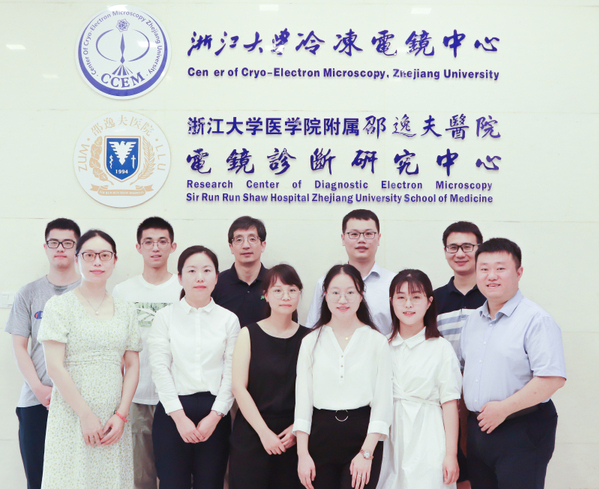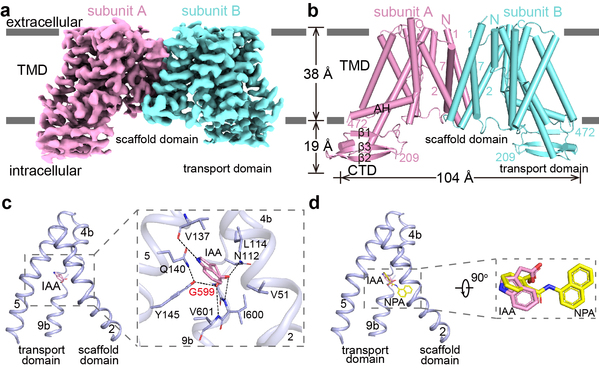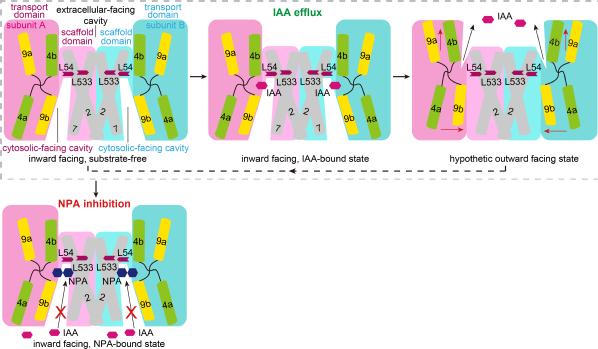Scientists unravel the molecular mechanism of PIN-mediated polar auxin transport
Auxin is the most important hormone in plants. It is mainly synthesized in cotyledons, young leaves and other growing tissues, and is transported to targeted issues via polar transport to regulate plant development and growth. How is this polar auxin transport (PAT) achieved?

The research team from Zhejiang University
Recently, the Zhejiang University-Hubei University joint team led by Dr. GUO Jiangtao from the Zhejiang University School of Medicine elaborated on the molecular mechanisms of the auxin transporter PIN-FORMED (PIN). Their study was published online in the journal Nature on August 2. As a major breakthrough in the study of PAT, their findings have cracked a hard nut regarding phototropism, thereby laying a solid foundation for the further regulation of PAT.
In the late 19th century, Charles Darwin, a famous British biologist who developed the theory of evolution, discovered that when the tip of coleoptile was exposed to unidirectional light, it would transmit some “influence” to the elongation zone below, causing the shaded side of the elongation zone to grow faster than the sunny side. The plant ended up curvature toward the light. In 1928, Frits Warmolt Went, a Dutch biologist, confirmed that phototropism was triggered by a special type of chemical compound and termed it as auxin. Indol-3-acetic (IAA) was not isolated from higher plants until 1946.
Follow-up studies revealed that auxin was related to not only phototropism but also gravitropism and chemotropism. The response or orientation of a plant to a stimulus that acts with greater intensity from one direction than another is termed as tropism. This tropism is primarily caused by the polar distribution of auxin in plants. Therefore, PAT plays a pivotal role in this process.
PAT depends heavily on three auxin transporters: PIN-FORMED (PIN), auxin transporter protein 1 (AUX1), and ATP-binding cassette (ABC) transporters, among which PINs constitute the most crucial part of this PAT system. pin mutant is characterized by PAT defects, such as impaired phototropism and gravitropism. However, little is known about how PINs mediate the efflux of auxin.
GUO Jiangtao et al. determined the cryo-EM structures of Arabidopsis thaliana PIN3 (AtPIN3) in the apo state (AtPIN3apo) and in the IAA-bound state (AtPIN3IAA). AtPIN3 exists as a homodimer. In each subunit, AtPIN3 contains 10 transmembrane helices (TM1-10) and TM1-5 and TM6-10 are inverted structural repeats. AtPIN3apo and AtPIN3IAA are similar to each other in structure and in an inward-facing conformation. AtPIN3 is comprised of the scaffold domain and the transport domain. In AtPIN3IAA, IAA binds in an inward-facing pocket between the scaffold domain and the transport domain and have hydrogen-bonding and hydrophobic interactions with multiple conserved amino acid residues.

Structure of AtPIN3IAA and AtPIN3NPA
To validate the binding mode of IAA and AtPIN3, Dr. Guo and his colleagues established an in vitro radioactive 3H-labeled IAA transport assay. In comparison with wild-type (WT) AtPIN3, mutants showed reduced 3H-labeled IAA efflux activity. The dissociation constants KD for the IAA bound to WT AtPIN3 and mutant AtPIN3 were measured by the Surface Plasmon Resonance. Results showed that WT AtPIN3 exhibited a higher binding affinity for IAA. In addition, GUO Jiangtao et al. also used other methods for multiple verification, such as molecular dynamics simulation and structural comparison.
N-1-naphthylphthalamic acid (NPA) has been used as an inhibitor of auxin transporters for the study of the PAT mechanism. Plants treated with NPA show a practically identical phenotype to the pin1-1 mutant strain. The targets and mechanisms of NPA have long been open to contention.
The researchers analyzed the AtPIN3-NPA complex structure (AtPIN3NPA) and found that NPA bound at the substrate-binding site in AtPIN3, with a higher affinity than IAA. Therefore, NPA worked as a competitive inhibitor, occupied the binding site of the substrate auxin and inhibited potential conformational change in PINs during transport. On this basis, Dr. Guo’s team proposed the molecular mechanism of NPA inhibition on the PIN-mediated auxin transport.

Mechanism of IAA efflux and NPA inhibition on the PIN-mediated auxin transport
Not only does this study offer an insightful understanding of the long-awaited molecular mechanism of the PIN-mediated auxin transport, but it also opens up a new avenue for the development of PIN inhibitors. These inhibitors may serve as a useful research tool in the PAT study or an effective herbicide.
Image credit: The research team led by Dr. GUO Jiangtao